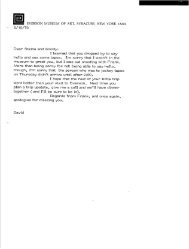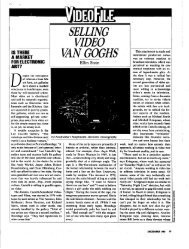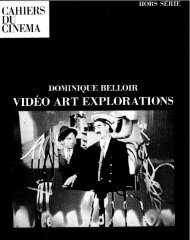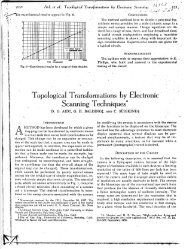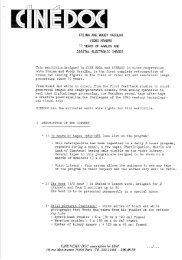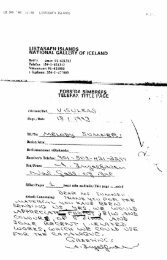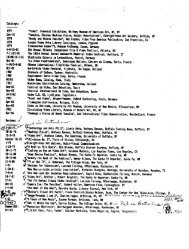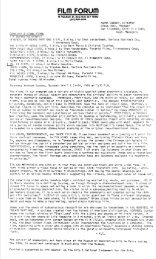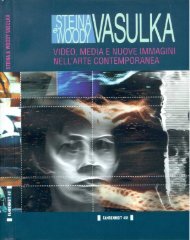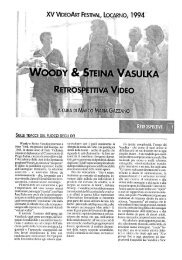MEDIA STUDY/BUFFALO - the Vasulkas
MEDIA STUDY/BUFFALO - the Vasulkas
MEDIA STUDY/BUFFALO - the Vasulkas
Create successful ePaper yourself
Turn your PDF publications into a flip-book with our unique Google optimized e-Paper software.
February 18 (Saturday)<br />
8:00 PM<br />
The Historical Society<br />
SAYAT NOVA (1969)<br />
(The Color of Pomegranates)<br />
Directed by Sergei Paradjanov. Color.<br />
72 minutes . Georgian and Armenian<br />
with English subtitles.<br />
Sayat Nova was completed in 1969, but<br />
not released in <strong>the</strong> Soviet Union until<br />
1973 . One year later, its director, <strong>the</strong><br />
Armenian filmmaker Sergei Paradjanov<br />
(Shadows of Our Forgotten Ancestors)<br />
was arrested, convicted of a<br />
number of trumped up charges, and<br />
sentenced to six years in <strong>the</strong> Gulag . In<br />
1977 a print of <strong>the</strong> film was smuggled<br />
into France, but it wasn't until <strong>the</strong><br />
Albert Dieudonne as Napoleon in Abel Lance's silent classic .<br />
March 3 (Saturday)<br />
8:00 PM<br />
The Historical Society<br />
NAPOLEON (1927)<br />
Directed by Abel Gance . With Albert<br />
Dieudonne, Antonin Artaud, Pierre<br />
Batcheff, Abel Gance, Gina Manes,<br />
and Annabella . Black and White . 270<br />
minutes . Silent with recorded musical<br />
score by Carmine Coppola . Finale in<br />
Polyvision .<br />
One of <strong>the</strong> major films of <strong>the</strong> silent<br />
cinema, Abel Lance's Napoleon has<br />
become perhaps <strong>the</strong> most celebrated<br />
"lost film" to be restored and revived .<br />
Its New York City debut in early 1981<br />
was <strong>the</strong> result of more than a decade<br />
of archival work by film historian Kevin<br />
Brownlow, as well as <strong>the</strong> financial as-<br />
spring of 1980, over a decade after its<br />
original production, that Sayat Nova<br />
was first screened in this country,<br />
where it has been hailed by <strong>the</strong> critics.<br />
The film depicts through a series of<br />
spectacular tableaux <strong>the</strong> youth of <strong>the</strong><br />
Armenian poet Sayat Nova . Despite <strong>the</strong><br />
loss of nearly a quarter of its running<br />
time and a re-editing job to include<br />
Russian intertitles, Sayat Nova confirms<br />
<strong>the</strong> visual artistry and poetic sensitivity<br />
of its maker. As J . Hoberman of<br />
<strong>the</strong> Village Voice noted, "Paradjanov's<br />
compositions are astonishing, and no<br />
one has ever made <strong>the</strong> olive-andorange<br />
tones of <strong>the</strong> Soviet color stock<br />
look better. A sublime and heartbreaking<br />
film ."<br />
sistance of filmmaker Francis Ford<br />
Coppola and <strong>the</strong> musical talents of<br />
composer Carmine Coppola . Lance,<br />
himself, lent a hand in this monumental<br />
undertaking .<br />
When he had originally released<br />
Napoleon in Paris in <strong>the</strong> spring of 1927,<br />
<strong>the</strong> film was 28-reels long and ran<br />
nearly five hours . There were four entire<br />
sections presented in Polyvision,<br />
Lance's spectacular triple-screen<br />
process, and it was accompanied by a<br />
score from <strong>the</strong> distinguished French<br />
composer, Arthur Honegger. However,<br />
Napoleon was screened on this epic<br />
scale in only a handful of European cities,<br />
and when it was released by MGM<br />
in <strong>the</strong> United States, <strong>the</strong> film was cut<br />
to 8 reels and presented without any<br />
February 25 (Saturday)<br />
8:00 PM<br />
The Historical Society<br />
WILLIAM K. EVERSON<br />
Presents THE KING OF JAZZ<br />
(1930)<br />
Directed by John Murray Anderson .<br />
With Bing Crosby, John Boles, Paul<br />
Whiteman and His Orchestra, and<br />
o<strong>the</strong>rs. Two-Color Technicolor. 120<br />
minutes .<br />
This rarely-seen Technicolor film is a<br />
fine example of that early form of <strong>the</strong><br />
American movie musical, <strong>the</strong> staged<br />
revue film . Abandoning story and dramatic<br />
continuity for <strong>the</strong> pure pleasures<br />
of "all singing, all dancing, all talking,"<br />
such films dominated movie-making in<br />
<strong>the</strong> early sound period . The King of<br />
Jazz was Universal's contribution to <strong>the</strong><br />
form and featured a variety of songs,<br />
of <strong>the</strong> Polyvision sequences . As Brownlow<br />
has noted, "They never released<br />
<strong>the</strong> full version in America, being unwilling<br />
to risk a Polyvision revolution on<br />
top of <strong>the</strong> talkie upheaval ."<br />
Gance re-released Napoleon several<br />
times, reworking it variously into a<br />
two-hour stereophonic sound feature in<br />
1934, a 21/4-hour sound feature with<br />
Polyvision sequences in 1955, and finally,<br />
<strong>the</strong> four-hour Bonaparte and <strong>the</strong><br />
Revolution (1971), which featured an introductory<br />
color sequence . Brownlow,<br />
a British filmmaker, editor, and historian,<br />
gained access to <strong>the</strong> negatives for<br />
<strong>the</strong> film during this final Lance sound<br />
version and, drawing on <strong>the</strong> resources<br />
of nearly every major film archive in <strong>the</strong><br />
dances, and musical routines by musical<br />
and non-musical talents alike.<br />
'Jazz" performances include those by<br />
Paul Whiteman and His Orchestra (minus<br />
Bix Heiderbecke, regrettably), Bing<br />
Crosby and <strong>the</strong> Rhythm Boys, The Sisters<br />
G ., and <strong>the</strong> Tommy Atkins Sextette,<br />
among o<strong>the</strong>rs .<br />
Notable among <strong>the</strong> film's musical<br />
production numbers are its "Rhapsody<br />
in Blue" sequence, performed by a<br />
bevy of chorus girls, and its spectacular<br />
finale, in which <strong>the</strong> genesis of jazz<br />
is apocryphally traced back through<br />
<strong>the</strong> musical traditions of various<br />
nations .<br />
Popular film historian William K .<br />
Everson, professor of cinema at New<br />
York University and author of The<br />
Western and American Silent Film, will<br />
introduce and discuss this rare movie<br />
musical .<br />
Photo : MOMA Film Stills Archive .<br />
world, pieced toge<strong>the</strong>r <strong>the</strong> most complete<br />
print of <strong>the</strong> film presented since<br />
<strong>the</strong> original 1927 release . To complement<br />
Brownlow's impressive restoration<br />
of Napoleon, composer Carmine<br />
Coppola prepared a new orchestral<br />
score for <strong>the</strong> film consisting predominantly<br />
of his own original music .<br />
It was with this Brownlow-restored print<br />
(including a Polyvision finale) and <strong>the</strong><br />
Coppola score that Napoleon was "discovered"<br />
by thousands of fortunate<br />
filmgoers during its recent release. Our<br />
screening will consist of <strong>the</strong> complete<br />
Brownlow print with <strong>the</strong> recorded orchestral<br />
score by Carmine Coppola .



